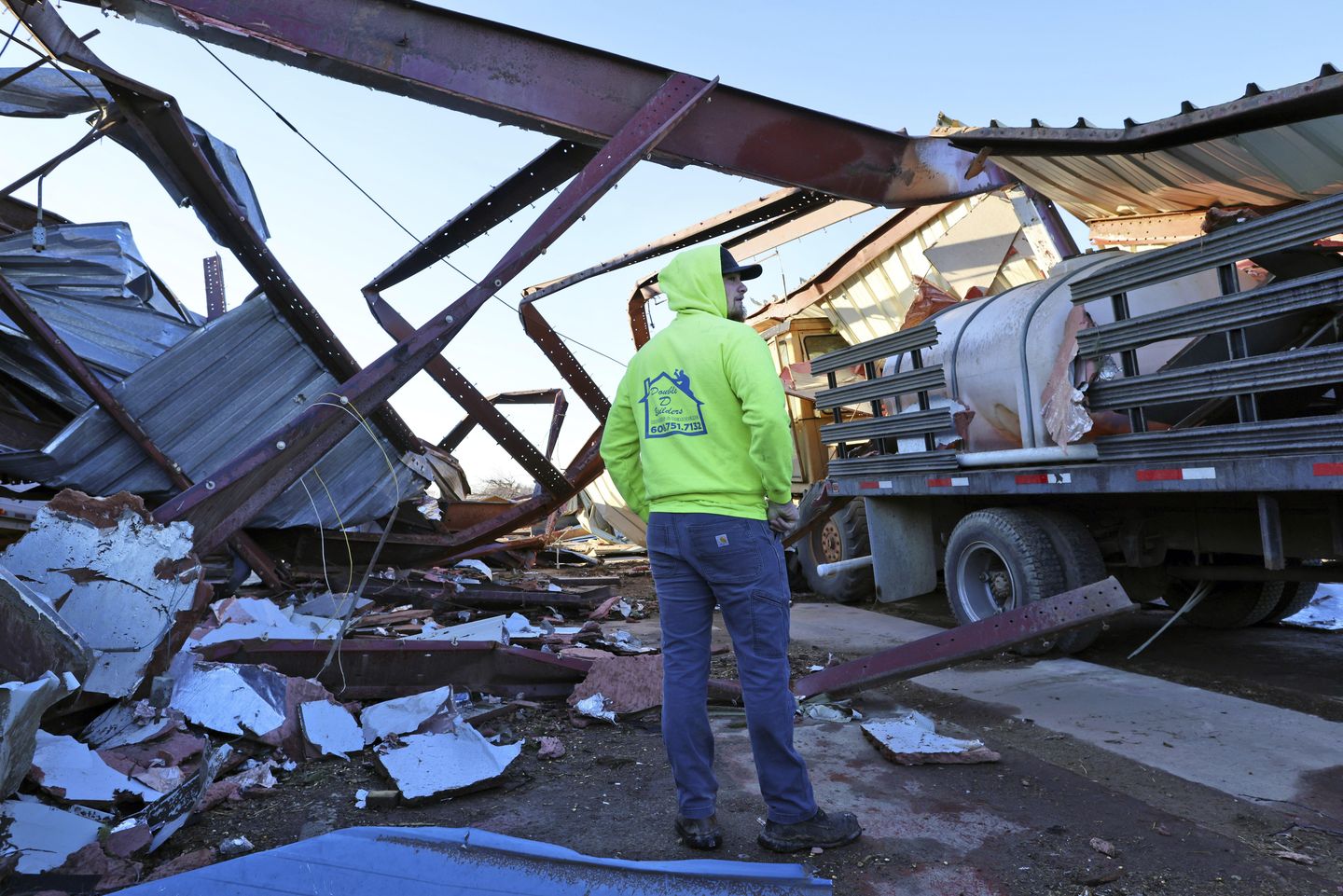
EVANSVILLE, Wis. (AP) — The first tornado ever recorded in Wisconsin in the usually frigid month of February that tore through mostly rural areas came on a day that broke records for warmth, setting up the perfect scenario for the type of severe weather normally seen in the late spring and summer.
The storms left a swath of destruction that included dead and missing cows, roofs blown off of homes, destroyed storage sheds and barns, trashed vehicles and shattered windows.
At least one tornado was confirmed south of Madison and the National Weather Service was investigating reports of several more spawned from storms that swept across the southeastern part of the state around 5:30 p.m. on Thursday, said meteorologist Taylor Patterson.
There were no reports of significant injuries. Local emergency management officials reported dozens of buildings, power lines and other structures that were damaged in the path of the storm that formed in eastern Iowa and died out near Milwaukee. The temperature was a record high for the date: 59 degrees (15 Celsius).
Connie Arndt, 72, stood in disbelief Friday among the debris of a rental house she owned outside Evansville.
“All of us are in denial that this is February,” she said. “It’s an absolute shock.”
Matt Artis, 34, said he had just got out of the shower in his family’s Town of Porter farmhouse on Thursday evening when he heard a “big bang.” He got his mother and their dog, Dixie, into the bathroom just as the tornado hit. He said he emerged from the bathroom, looked up and saw nothing but the night sky. The tornado had torn the roof from their home.
Outside, the tornado had turned the farm’s 103-year-old barn to rubble and strewn debris across the fields for hundreds of yards. He said Friday morning that he found one his cows dead in the barn and 10 more were missing.
Artis appeared to be in shock, wandering around the farm as a small army of neighbors pulled up offering to help him find his cattle. At one point, he threw up his hands and walked away, saying: “I don’t know.”
Hunter Oller of Brodhead, Wisconsin, and his friend were out fishing when the storm rolled in. They started to drive home but pulled over in the Town of Magnolia where they spotted two partially formed tornadoes and one tornado that seemed to touch the ground. Oller, 20, pulled out his cellphone.
“I was in awe,” he said.
Patterson, the meteorologist, said the storm was like ones typically seen in Wisconsin in the late spring and summer.
“It’s just unusual in the sense that it doesn’t normally happen in February,” she said.
Winter tornadoes are almost unheard of, especially in northern states.
The National Oceanic and Atmospheric Administration reported that between 1998 and 2022, 31 states across a broad swath of the country, from Washington state in the northwest to New Mexico in the south, Wisconsin in the Upper Midwest over to Maine in the northeast, didn’t report a single tornado.
But winter tornadoes – like the one in Wisconsin – are likely to be stronger and stay on the ground longer with a wider swath of destruction in a warming world, a 2021 study showed. That comes after a 2018 study found that tornadoes were moving farther east, into states like Wisconsin.
The stronger El Nino this year does make it warmer than normal, but it’s hard to say from this one event how significant of a role climate change played, the meteorologist Patterson said.
“But with a lot of things that have been going on with climate change, you get more severe events and then you get more impactful severe events,” she said.
Tornadoes are most common in Wisconsin over the summer months between May and August. Since 1948, between November and February fewer than a dozen tornadoes total had been reported before Thursday, according to the weather service.
Conditions collided in Wisconsin late afternoon on Thursday creating the perfect conditions for tornadoes to form, Patterson said. That included rapidly warming temperatures that topped out at a record-tying 55 degrees Fahrenheit (13 Celsius) in Madison and more moisture with rapidly rising air, creating thunderstorms, Patterson said.
Weather service teams will determine how strong the tornadoes were and how many formed. Photos and video shot near Evansville, Wisconsin, that were posted on social media show a tornado with lightning flashing around it.
Dan Wagner, 76, and his 40-year-old son, Andy, couldn’t make it to the basement before the tornado hit their house near the Artis farm.
Andy Wagner said he curled into a ball and hoped for the best as windows shattered and the sound of metal on metal filled their home.
“It was like the house took a deep breath, and (then) the windows all exploded. I’m in the fetal position on the floor,” he said. “I thought I was going to die.”

